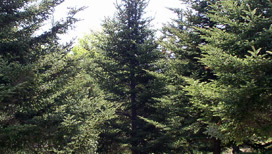Real Christmas Trees Make Sense!
Whether they tend to use a fresh Christmas tree or an artificial one, most folks will agree that the allure of a real tree is its scent, and the way it "just feels right" to have a traditional live tree in the house. While there are some practical reasons for their restriction in some public buildings, most household complaints about needle drop, fire hazard, and mischievous children or pets can be addressed by a few simple tips, and a bit of tree-education.
Our association and our farmers are committed to encouraging the choice of a "real tree" for holiday decorating. The days of a family driving off into the country to chop down a wild tree are past. Christmas trees are an agricultural crop, are often planted on steep hillsides where other crops, and even cattle, are not practical. So buying a live tree is not going to deplete our forests. To the contrary, fields of Christmas trees have a lot of positive impact on our enviroment, and they can be recycled.
The following article, used here with permission of the National Christmas Tree Association, explains these benefits.
Remember: Real Christmas trees make SCENTS!
Real Christmas Trees Are a Benefit to the Environment.
While they're growing, Real Christmas Trees support life by absorbing carbon dioxide and other gases and emitting fresh oxygen.
Every acre of Christmas Trees grown produces the daily oxygen requirement for 18 people.
In the United States, there are approximately 500,000 acres of Christmas Trees, which means that 9 million people a day are supplied with oxygen thanks to these trees.
The farms that grow Christmas Trees stabilize soil, protect water supplies and provide refuge for wildlife while creating scenic green belts. Often, Christmas Trees are grown on soil that doesn't support other crops.
Real Christmas Trees Are Renewable and Recyclable.
Real Christmas Trees are grown on farms just like any other crop. To ensure a constant supply, Christmas Tree growers plant one to three new seedlings for every tree they harvest.
On the other hand, artificial trees are a petroleum-based product manufactured primarily in Chinese factories. The average family uses an artificial tree for only six to nine years before throwing it away, where it will remain in a landfill for centuries after disposal.
Don't just take our word for it - see what other environmental experts have to say on the subject...
- A Real Tree is five times more environmentally compatible than a plastic tree, according to this study by Swedish researchers.
- The former president of Greenpeace, Dr. Patrick Moore, endorses Real Trees as the best environmental option for consumers.
- The polyvinyl chloride (PVC) used in most artificial trees is boycotted by environmental groups. Read about the dangers of PVC.
- The American Forests organization also supports the growth and use of Real Christmas Trees for many reasons.
- For environmental reasons, Yoga Journal recommends a live or cut Christmas Tree over the use of an artificial tree.
- According to an article in Newsweek, experts recommend that you should "always go real."

